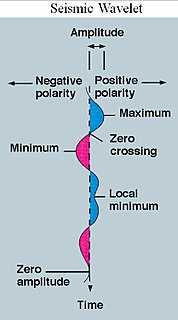Inverse modeling is a mathematical technique where the objective is to determine the physical properties of the subsurface of an earth region that has produced a given seismogram. Cooke and Schneider (1983) [1] defined it as calculation of the earth’s structure and physical parameters from some set of observed seismic data. The underlying assumption in this method is that the collected seismic data are from an earth structure that matches the cross-section computed from the inversion algorithm. [2] Some common earth properties that are inverted for include acoustic velocity, formation and fluid densities, acoustic impedance, Poisson's ratio, formation compressibility, shear rigidity, porosity, and fluid saturation.
An inverse problem in science is the process of calculating from a set of observations the causal factors that produced them: for example, calculating an image in X-ray computed tomography, source reconstruction in acoustics, or calculating the density of the Earth from measurements of its gravity field.

A seismogram is a graph output by a seismograph. It is a record of the ground motion at a measuring station as a function of time. Seismograms typically record motions in three cartesian axes, with the z axis perpendicular to the Earth's surface and the x- and y- axes parallel to the surface. The energy measured in a seismogram may result from an earthquake or from some other source, such as an explosion. Seismograms can record lots of things, and record many little waves, called microseisms. These tiny microseisms can be caused by heavy traffic near the seismograph, waves hitting a beach, the wind, and any number of other ordinary things that cause some shaking of the seismograph.

In mathematics and computer science, an algorithm is an unambiguous specification of how to solve a class of problems. Algorithms can perform calculation, data processing, automated reasoning, and other tasks.
Contents
- Linear inversion
- Forward model
- Objective function
- Mathematical analysis of generalized linear inversion procedure
- Solution algorithm
- Parameterization of the earth model space
- Inversion examples
- Temperature inversion from Marescot (2010)[8]
- Wave travel time inversion from Marescot (2010)[8]
- Seismic trace inversion from Cooke and Schneider (1983)
- References
- Further reading
The method has long been useful for geophysicists and can be categorized into two broad types: [3] Deterministic and stochastic inversion. Deterministic inversion methods are based on comparison of the output from an earth model with the observed field data and continuously updating the earth model parameters to minimize a function, which is usually some form of difference between model output and field observation. As such, this method of inversion to which linear inversion falls under is posed as an minimization problem and the accepted earth model is the set of model parameters that minimizes the objective function in producing a numerical seismogram which best compares with collected field seismic data.
In computer science, a deterministic algorithm is an algorithm which, given a particular input, will always produce the same output, with the underlying machine always passing through the same sequence of states. Deterministic algorithms are by far the most studied and familiar kind of algorithm, as well as one of the most practical, since they can be run on real machines efficiently.
The word stochastic is an adjective in English that describes something that was randomly determined. The word first appeared in English to describe a mathematical object called a stochastic process, but now in mathematics the terms stochastic process and random process are considered interchangeable. The word, with its current definition meaning random, came from German, but it originally came from Greek στόχος (stókhos), meaning 'aim, guess'.
On the other hand, stochastic inversion methods are used to generate constrained models as used in reservoir flow simulation, using geostatistical tools like kriging. As opposed to deterministic inversion methods which produce a single set of model parameters, stochastic methods generate a suite of alternate earth model parameters which all obey the model constraint. However, the two methods are related as the results of deterministic models is the average of all the possible non-unique solutions of stochastic methods. [3] Since seismic linear inversion is a deterministic inversion method, the stochastic method will not be discussed beyond this point.

A reservoir is, most commonly, an enlarged natural or artificial lake, pond or impoundment created using a dam or lock to store water.

In statistics, originally in geostatistics, kriging or Gaussian process regression is a method of interpolation for which the interpolated values are modeled by a Gaussian process governed by prior covariances. Under suitable assumptions on the priors, kriging gives the best linear unbiased prediction of the intermediate values. Interpolating methods based on other criteria such as smoothness need not yield the most likely intermediate values. The method is widely used in the domain of spatial analysis and computer experiments. The technique is also known as Wiener–Kolmogorov prediction, after Norbert Wiener and Andrey Kolmogorov.














































































